 Facebook
Facebook
 X
X
 Instagram
Instagram
 TikTok
TikTok
 Youtube
Youtube
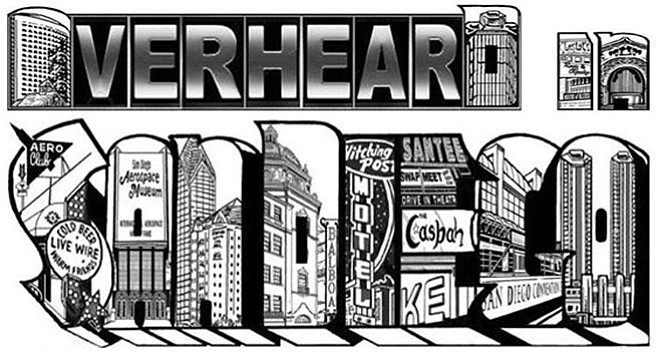
I never wanted to be a cartoonist.
And yet, I’m about to draw the 1000th weekly edition of Overheard in San Diego.
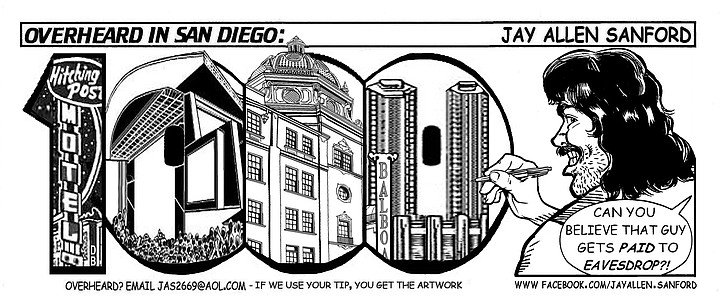
Sure, I loved and collected comic books as a kid, and even drew cartoons for my middle- and high-school newspapers. But my focus from the start was on writing, first for those publications, then with self-published fiction zines, and eventually freelancing for newsstand magazines, mostly writing about film and pop culture (Starlog, FilmFax, Cult Movies, and others).
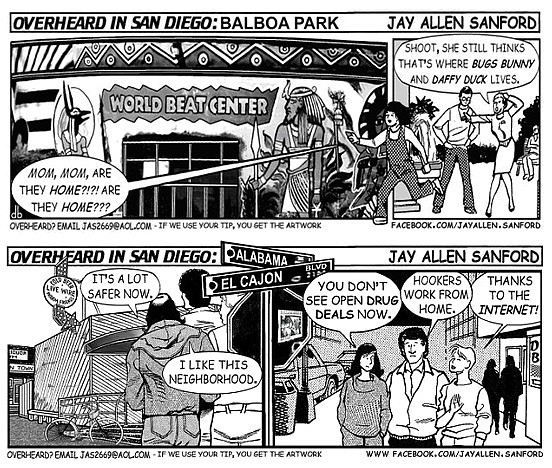
I pretty much stopped drawing after I first arrived in San Diego via Greyhound in the late ’70s, though not before earning my first California cash with a paper pad and colored-pencil kit pulled from my backpack that afternoon. My buddies at school had always liked my comic caricatures — funny cartoons about friends and frequently unsavory ’toons concerning school administrators — so I thought I’d go to Balboa Park and earn some scratch drawing tourists and locals, as I’d witnessed during my first visit to the city. I even brought some of those high-school sketches to use as display samples.
Unfortunately, rendering familiar friends and foes is different from drawing complete strangers who glare at you impatiently from atop the drawing pad. At least half the people I drew that day refused to pay my (crudely) handmade sign’s “suggested” five-dollar donation. One couple gave me a quarter. Nobody tipped me.
Pretty much everyone looked at my artwork like it was something they couldn’t wait to scrape off their shoe.
I was mortified. And broke. But I stayed in San Diego and eventually found paying work in the comic-book publishing biz at Miramar’s Pacific Comics, home of the Rocketeer, Jack Kirby’s Captain Victory, and more. Not as an artist; I worked in the shipping warehouse. It would be several more years before I scripted my first comic book.
Even then, for the entire time I wrote and edited titles like Rock ’N’ Roll Comics for Hillcrest’s Revolutionary Comics (1989–1994), the company never published a piece of my artwork (though I did occasionally draw embarrassingly rough thumbnails as artist guidelines). Ditto the period I served as publisher for Carnal Comics (1994–2000), where I scripted something like a hundred issues, two stories per, without drawing a single panel.
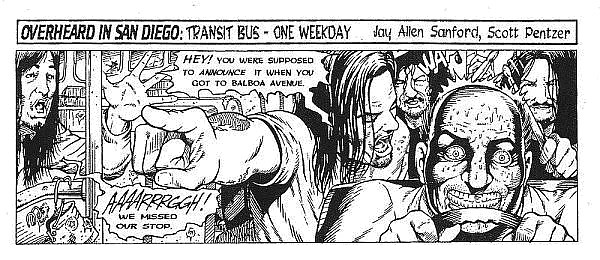
By late 1995, I was already writing for the Reader, usually for the music section. When the Blurt column ran short one week, I spent around an hour or so mocking up my idea for a one-shot filler cartoon, using artwork from an earlier strip I’d done with Kiss comics artist Scott Pentzer. Unpublished before now, that pilot strip featured a stressed-out bus driver.
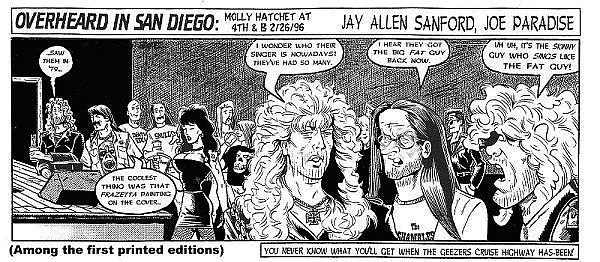
The editor was enthusiastic, and soon the paper commissioned the strip as a weekly Blurt feature. I immediately teamed up with Rock ’N’ Roll Comics artist Joe Paradise, whose established skill at drawing recognizable people and places made him the ideal penman. Over the next couple of years, our work appeared in the Reader every seven days. The dialogue usually came from nights I spent on the town working on Reader stories, and then tipsters began submitting their own bits of overheard chatter.
Until the strip became known around town, I ran into problems at a few venues. Velvet, on Kettner (which came to occupy the Casbah’s first location after that club moved down the road), wouldn’t let me photograph the place, especially the sticker-covered door, even after I explained that the artist needed photo references and the club would be getting free publicity in the Reader. The operator accused me of some sort of industrial espionage, so only the exterior of the place appeared in the final strip, with word balloons pointing inside the door.
Empire booted me after someone in a comic called the goth club’s patrons “airheads and pinheads,” something I may have overheard but would never have agreed with. I loved that place and its adventurous play-list, and didn’t mind the patrons at all, at least the ones I could espy through all the dry-ice fogbanks.
The Boulevard in La Mesa banned me after their stage was referred to in a character’s derogatory comment (“the size of a postage stamp”), and that was particularly disappointing for me, it being my favored neighborhood bar, just half a block from where I was living. Casbah honcho Tim Mays wrote a letter of complaint to the paper about my “silly little comic strip” after I apparently exposed one frequent guest band’s penchant for setting their instruments on fire to investigative scrutiny from the fire marshal (oops!).
Around two years into Overheard’s run, though, I began seeing cutout copies of the strip mounted behind the bar and on cash registers at several places around the city. Few knew I was the “Overheard Guy”; all I did in public was jot down notes — I was still just writing the strips. One time, I actually overheard someone at Rudford’s saying, “Someone needs to send that one to Overheard in San Diego.”
Then, Joe Paradise was no longer available to draw the comic. I was stuck with the task of either hiring a new artist or drawing the thing myself. Which at first seemed a ludicrous notion.
Of course, once I realized that drawing it myself meant I no longer had to split the paycheck, my choice was clear.
And thus, at the age of 38, I became a cartoonist. My crash tutorial included books on the art form, such as Understanding Comics, by Scott McCloud; Comics & Sequential Art, by Will Eisner; and a series of how-to-draw books by Tarzan artist Burne Hogarth. I recycled a lot of Paradise artwork (still do, actually), as I studied how to render in a similar style.
My first solo Overheard comic debuted in 1998. No, it won’t be reproduced here. I’m still amazed the Reader didn’t fire me.

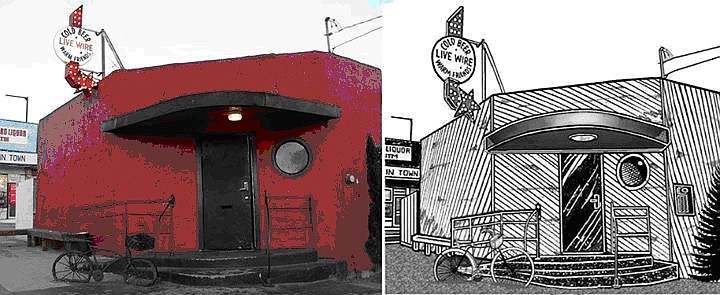
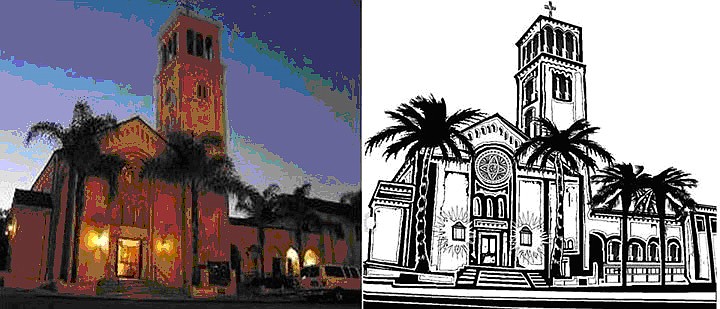
Once I got comfortable with the tools of my new trade, particularly after I mastered digitizing backgrounds from photos, the comics grew from barely competent to halfway decent to, I think, not at all terrible.
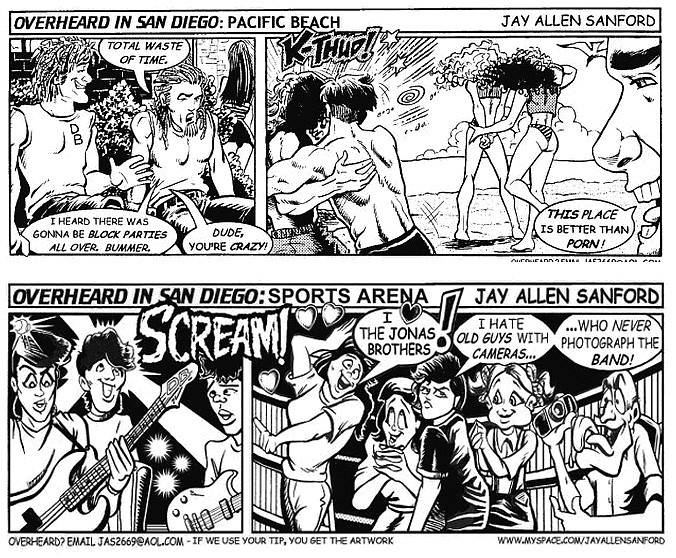
So, basically, Overheard in San Diego is about taking odd excerpted slices of reality and rendering them into black-and-white linework that both maintains and magnifies while (ideally) entertaining. I believe the old saying, “Truth is stranger than fiction.” It’s certainly more interesting.
"Overheard in San Diego" theme song by Cathryn Beeks & Sven-Erik Seaholm performed live during Overheard art show
As you may or may not know, I depend on tipsters to email me stuff they’ve overheard around town. Whoever sends me a tip that gets illustrated gets to keep the original artwork for that week’s comic, often a mix of digital and hand-drawn art. At this point, I’ve given away the majority of Overheard artwork (which made it hard to come up with enough artboards to display at recent gallery showings).
For tipsters, the things I look for are:
— The strip should be music related (ideally), and it must be local.
— A local setting that’d be fun to draw (club with unique decor, an iconic local landmark or building, lots of interesting-looking people, etc.).
—Dialogue that comes across as either funny, head-scratching, utterly inexplicable, or so perfectly suited to its locale and/or the speakers that it’s almost like illustrating a cliché.
— “Guest star” caricatures from the actual event, including well-known/recognizable locals or visiting celebs.
If you think you have good bits of overheard chatter, feel free to email me.
I recently took a batch of unused Overheard tips to Alonso Nunez at O.B.’s Little Fish Comic Book Studio, an artist co-op where students from preschool age through their teens study and practice cartooning. Nunez also hosts workshops at area schools like Wilson Middle School, as well as heading student field trips to local comic conventions.
Nunez tasked several Little Fish students (age 10 to 19) to draw their own versions of Overheard, based on those unused tips. We were so delighted with their creativity that we want to share the student strips with readers and invite you to vote for your favorite.
The student whose comic strip receives the most votes will have that Overheard comic published in an upcoming issue of the print edition, with their solo byline that week’s paycheck. Voting lasts until March 25, 2015. The winner will be announced in the Reader on April 1.
As I near my 20th year of being San Diego’s Overheard Guy, I can’t even tell you how often I’ve seen the comics displayed around town or how many hysterical/weird/scary/head-scratching tips and comments I’ve received from readers.
I once mentioned to a lovely woman on a flight from Atlanta to San Diego that I was the artist behind Overheard. She reached into her purse to pull out a wallet where she kept one of the comics about a blues club she used to manage.
When I was first invited into a new neighbor’s home, the guy had several Overheard comics taped onto his fridge. He had no idea I was their creator.
My goddaughter Christie, already a far better artist than I was when I drew my first solo Overheard, wants to apprentice on the strip and eventually take it over, whenever I decide to put down my pen (when that may be depends on how tight I’m up against the next deadline when you ask). As someone with no children of my own, it’s hard to describe how solid, how successful, how immortal that makes me feel.
And to see the Little Fish students’ interpretations of the comic, the next generation, San Diego’s upcoming and ongoing cartoonists of the future… I’m honored and humbled. Amazing, really, to think that one single hour spent mocking up a filler graphic in 1995 has led to 1000 strips and counting, which I hope you’ve enjoyed.
I may not have wanted to become a cartoonist. But I’m glad I did.


I never wanted to be a cartoonist.
And yet, I’m about to draw the 1000th weekly edition of Overheard in San Diego.

Sure, I loved and collected comic books as a kid, and even drew cartoons for my middle- and high-school newspapers. But my focus from the start was on writing, first for those publications, then with self-published fiction zines, and eventually freelancing for newsstand magazines, mostly writing about film and pop culture (Starlog, FilmFax, Cult Movies, and others).

I pretty much stopped drawing after I first arrived in San Diego via Greyhound in the late ’70s, though not before earning my first California cash with a paper pad and colored-pencil kit pulled from my backpack that afternoon. My buddies at school had always liked my comic caricatures — funny cartoons about friends and frequently unsavory ’toons concerning school administrators — so I thought I’d go to Balboa Park and earn some scratch drawing tourists and locals, as I’d witnessed during my first visit to the city. I even brought some of those high-school sketches to use as display samples.
Unfortunately, rendering familiar friends and foes is different from drawing complete strangers who glare at you impatiently from atop the drawing pad. At least half the people I drew that day refused to pay my (crudely) handmade sign’s “suggested” five-dollar donation. One couple gave me a quarter. Nobody tipped me.
Pretty much everyone looked at my artwork like it was something they couldn’t wait to scrape off their shoe.
I was mortified. And broke. But I stayed in San Diego and eventually found paying work in the comic-book publishing biz at Miramar’s Pacific Comics, home of the Rocketeer, Jack Kirby’s Captain Victory, and more. Not as an artist; I worked in the shipping warehouse. It would be several more years before I scripted my first comic book.
Even then, for the entire time I wrote and edited titles like Rock ’N’ Roll Comics for Hillcrest’s Revolutionary Comics (1989–1994), the company never published a piece of my artwork (though I did occasionally draw embarrassingly rough thumbnails as artist guidelines). Ditto the period I served as publisher for Carnal Comics (1994–2000), where I scripted something like a hundred issues, two stories per, without drawing a single panel.

By late 1995, I was already writing for the Reader, usually for the music section. When the Blurt column ran short one week, I spent around an hour or so mocking up my idea for a one-shot filler cartoon, using artwork from an earlier strip I’d done with Kiss comics artist Scott Pentzer. Unpublished before now, that pilot strip featured a stressed-out bus driver.

The editor was enthusiastic, and soon the paper commissioned the strip as a weekly Blurt feature. I immediately teamed up with Rock ’N’ Roll Comics artist Joe Paradise, whose established skill at drawing recognizable people and places made him the ideal penman. Over the next couple of years, our work appeared in the Reader every seven days. The dialogue usually came from nights I spent on the town working on Reader stories, and then tipsters began submitting their own bits of overheard chatter.
Until the strip became known around town, I ran into problems at a few venues. Velvet, on Kettner (which came to occupy the Casbah’s first location after that club moved down the road), wouldn’t let me photograph the place, especially the sticker-covered door, even after I explained that the artist needed photo references and the club would be getting free publicity in the Reader. The operator accused me of some sort of industrial espionage, so only the exterior of the place appeared in the final strip, with word balloons pointing inside the door.
Empire booted me after someone in a comic called the goth club’s patrons “airheads and pinheads,” something I may have overheard but would never have agreed with. I loved that place and its adventurous play-list, and didn’t mind the patrons at all, at least the ones I could espy through all the dry-ice fogbanks.
The Boulevard in La Mesa banned me after their stage was referred to in a character’s derogatory comment (“the size of a postage stamp”), and that was particularly disappointing for me, it being my favored neighborhood bar, just half a block from where I was living. Casbah honcho Tim Mays wrote a letter of complaint to the paper about my “silly little comic strip” after I apparently exposed one frequent guest band’s penchant for setting their instruments on fire to investigative scrutiny from the fire marshal (oops!).
Around two years into Overheard’s run, though, I began seeing cutout copies of the strip mounted behind the bar and on cash registers at several places around the city. Few knew I was the “Overheard Guy”; all I did in public was jot down notes — I was still just writing the strips. One time, I actually overheard someone at Rudford’s saying, “Someone needs to send that one to Overheard in San Diego.”
Then, Joe Paradise was no longer available to draw the comic. I was stuck with the task of either hiring a new artist or drawing the thing myself. Which at first seemed a ludicrous notion.
Of course, once I realized that drawing it myself meant I no longer had to split the paycheck, my choice was clear.
And thus, at the age of 38, I became a cartoonist. My crash tutorial included books on the art form, such as Understanding Comics, by Scott McCloud; Comics & Sequential Art, by Will Eisner; and a series of how-to-draw books by Tarzan artist Burne Hogarth. I recycled a lot of Paradise artwork (still do, actually), as I studied how to render in a similar style.
My first solo Overheard comic debuted in 1998. No, it won’t be reproduced here. I’m still amazed the Reader didn’t fire me.



Once I got comfortable with the tools of my new trade, particularly after I mastered digitizing backgrounds from photos, the comics grew from barely competent to halfway decent to, I think, not at all terrible.

So, basically, Overheard in San Diego is about taking odd excerpted slices of reality and rendering them into black-and-white linework that both maintains and magnifies while (ideally) entertaining. I believe the old saying, “Truth is stranger than fiction.” It’s certainly more interesting.
"Overheard in San Diego" theme song by Cathryn Beeks & Sven-Erik Seaholm performed live during Overheard art show
As you may or may not know, I depend on tipsters to email me stuff they’ve overheard around town. Whoever sends me a tip that gets illustrated gets to keep the original artwork for that week’s comic, often a mix of digital and hand-drawn art. At this point, I’ve given away the majority of Overheard artwork (which made it hard to come up with enough artboards to display at recent gallery showings).
For tipsters, the things I look for are:
— The strip should be music related (ideally), and it must be local.
— A local setting that’d be fun to draw (club with unique decor, an iconic local landmark or building, lots of interesting-looking people, etc.).
—Dialogue that comes across as either funny, head-scratching, utterly inexplicable, or so perfectly suited to its locale and/or the speakers that it’s almost like illustrating a cliché.
— “Guest star” caricatures from the actual event, including well-known/recognizable locals or visiting celebs.
If you think you have good bits of overheard chatter, feel free to email me.
I recently took a batch of unused Overheard tips to Alonso Nunez at O.B.’s Little Fish Comic Book Studio, an artist co-op where students from preschool age through their teens study and practice cartooning. Nunez also hosts workshops at area schools like Wilson Middle School, as well as heading student field trips to local comic conventions.
Nunez tasked several Little Fish students (age 10 to 19) to draw their own versions of Overheard, based on those unused tips. We were so delighted with their creativity that we want to share the student strips with readers and invite you to vote for your favorite.
The student whose comic strip receives the most votes will have that Overheard comic published in an upcoming issue of the print edition, with their solo byline that week’s paycheck. Voting lasts until March 25, 2015. The winner will be announced in the Reader on April 1.
As I near my 20th year of being San Diego’s Overheard Guy, I can’t even tell you how often I’ve seen the comics displayed around town or how many hysterical/weird/scary/head-scratching tips and comments I’ve received from readers.
I once mentioned to a lovely woman on a flight from Atlanta to San Diego that I was the artist behind Overheard. She reached into her purse to pull out a wallet where she kept one of the comics about a blues club she used to manage.
When I was first invited into a new neighbor’s home, the guy had several Overheard comics taped onto his fridge. He had no idea I was their creator.
My goddaughter Christie, already a far better artist than I was when I drew my first solo Overheard, wants to apprentice on the strip and eventually take it over, whenever I decide to put down my pen (when that may be depends on how tight I’m up against the next deadline when you ask). As someone with no children of my own, it’s hard to describe how solid, how successful, how immortal that makes me feel.
And to see the Little Fish students’ interpretations of the comic, the next generation, San Diego’s upcoming and ongoing cartoonists of the future… I’m honored and humbled. Amazing, really, to think that one single hour spent mocking up a filler graphic in 1995 has led to 1000 strips and counting, which I hope you’ve enjoyed.
I may not have wanted to become a cartoonist. But I’m glad I did.
Comments